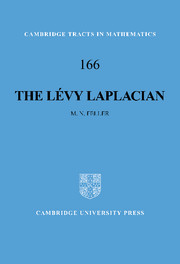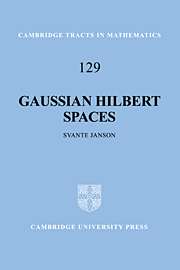Refine search
Actions for selected content:
3023 results in Probability theory and stochastic processes
1 - Introduction
-
- Book:
- An Introduction to Random Matrices
- Published online:
- 03 February 2011
- Print publication:
- 19 November 2009, pp 1-5
-
- Chapter
- Export citation
Contents
-
- Book:
- An Introduction to Random Matrices
- Published online:
- 03 February 2011
- Print publication:
- 19 November 2009, pp vii-xii
-
- Chapter
- Export citation
4 - Some generalities
-
- Book:
- An Introduction to Random Matrices
- Published online:
- 03 February 2011
- Print publication:
- 19 November 2009, pp 186-321
-
- Chapter
- Export citation

The Lévy Laplacian
-
- Published online:
- 02 November 2009
- Print publication:
- 24 November 2005

Gaussian Hilbert Spaces
-
- Published online:
- 21 October 2009
- Print publication:
- 12 June 1997
Frontmatter
-
- Book:
- Random Matrices: High Dimensional Phenomena
- Published online:
- 05 March 2012
- Print publication:
- 08 October 2009, pp i-vi
-
- Chapter
- Export citation
13 - From the Ornstein–Uhlenbeck process to the Burgers equation
-
- Book:
- Random Matrices: High Dimensional Phenomena
- Published online:
- 05 March 2012
- Print publication:
- 08 October 2009, pp 392-410
-
- Chapter
- Export citation
10 - Fluctuations and the Tracy–Widom distribution
-
- Book:
- Random Matrices: High Dimensional Phenomena
- Published online:
- 05 March 2012
- Print publication:
- 08 October 2009, pp 321-351
-
- Chapter
- Export citation
References
-
- Book:
- Random Matrices: High Dimensional Phenomena
- Published online:
- 05 March 2012
- Print publication:
- 08 October 2009, pp 424-432
-
- Chapter
- Export citation
4 - Free entropy and equilibrium
-
- Book:
- Random Matrices: High Dimensional Phenomena
- Published online:
- 05 March 2012
- Print publication:
- 08 October 2009, pp 132-176
-
- Chapter
- Export citation
5 - Convergence to equilibrium
-
- Book:
- Random Matrices: High Dimensional Phenomena
- Published online:
- 05 March 2012
- Print publication:
- 08 October 2009, pp 177-195
-
- Chapter
- Export citation
6 - Gradient flows and functional inequalities
-
- Book:
- Random Matrices: High Dimensional Phenomena
- Published online:
- 05 March 2012
- Print publication:
- 08 October 2009, pp 196-226
-
- Chapter
- Export citation
12 - Hermite polynomials
-
- Book:
- Random Matrices: High Dimensional Phenomena
- Published online:
- 05 March 2012
- Print publication:
- 08 October 2009, pp 373-391
-
- Chapter
- Export citation
Introduction
-
- Book:
- Random Matrices: High Dimensional Phenomena
- Published online:
- 05 March 2012
- Print publication:
- 08 October 2009, pp 1-3
-
- Chapter
- Export citation
9 - Integrable operators and differential equations
-
- Book:
- Random Matrices: High Dimensional Phenomena
- Published online:
- 05 March 2012
- Print publication:
- 08 October 2009, pp 281-320
-
- Chapter
- Export citation
8 - Random point fields and random matrices
-
- Book:
- Random Matrices: High Dimensional Phenomena
- Published online:
- 05 March 2012
- Print publication:
- 08 October 2009, pp 253-280
-
- Chapter
- Export citation
11 - Limit groups and Gaussian measures
-
- Book:
- Random Matrices: High Dimensional Phenomena
- Published online:
- 05 March 2012
- Print publication:
- 08 October 2009, pp 352-372
-
- Chapter
- Export citation
3 - Entropy and concentration of measure
-
- Book:
- Random Matrices: High Dimensional Phenomena
- Published online:
- 05 March 2012
- Print publication:
- 08 October 2009, pp 84-131
-
- Chapter
- Export citation
Index
-
- Book:
- Random Matrices: High Dimensional Phenomena
- Published online:
- 05 March 2012
- Print publication:
- 08 October 2009, pp 433-437
-
- Chapter
- Export citation
Contents
-
- Book:
- Random Matrices: High Dimensional Phenomena
- Published online:
- 05 March 2012
- Print publication:
- 08 October 2009, pp vii-x
-
- Chapter
- Export citation
